Lawyers, Guns and Money: California during the Interregnum of 1846-1848
The inclusion of California in Territorial Papers of the United States, 1763-1953, is perhaps surprising as that state was never formally organized as a territory prior to statehood in 1850. Rather, Alta (Upper) California, including much of Arizona, Utah and New Mexico, went through a two-year transitional period during the Mexican-American War when its status was undetermined. The “territory” that became the Mexican Cession following the Treaty of Guadalupe Hidalgo in 1848 was administered by the U.S. Army as a protectorate with the clear understanding that it would ultimately redound to the United States.
![Carta Esferica de la Costa de la Alta California [Spherical Map of the Coast of Upper California]. From Territorial Papers of the United States, Consular Despatches, Monterey California, Feb. 20, 1834-Nov. 15, 1848 TPUS California Image 1.png](/sites/default/files/blog/TPUS%20California%20Image%201.png)
The conquest and annexation of Upper California was the ultimate step in “Manifest Destiny,” a term coined in 1845 by journalist John O’Sullivan to articulate the sense that the American national project was to extend republican government from coast to coast, and that this task was sanctioned by God.
President James K. Polk was staunchly in favor of territorial expansion. In service of that end, in 1846 following the Texan Revolution he sent a token military force to erect a provisional fort across from Matamoros, Mexico in the disputed border area along the Rio Grande. This provoked a military response from the Mexican garrison which was used as a pretext for a formal declaration of war by the United States on May 13, 1846.
Although the war was initiated along the southern border of the Texas Republic, President Polk had Upper California very much in mind when he detailed John Charles Fremont to relocate his force of military engineers from Oregon to California in hope of fostering a rebellion.
It did not take long for Upper California to break away from Mexico. Barely a month after the declaration of war, on June 18, 1846 William B. Ide, leader of what would become the Bear Flag Republic, issued a proclamation from his Sonoma headquarters which reads in part,
To overthrow a government which has seized upon the property of the Missions for its individual aggrandizement; who has ruined and shamefully oppressed the laboring people of California, by their enormous exactions on goods imported into the country, is the determined purpose of the brave men who are associated under my command.

The Bear Flag Republic was named after its emblem which still serves today as California’s state flag. This nascent government was limited to an area around Sonoma, and lasted just over three weeks until the separatist forces united with those of Fremont to form the California Battalion in July 1846.
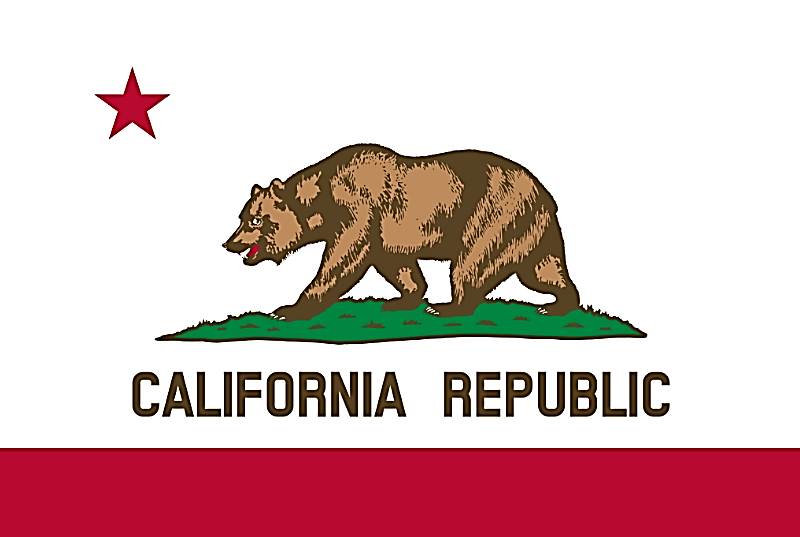
Shortly afterwards, on July 29, 1846, U.S. Navy Commodore Robert F. Stockton framed the initial takeover in more benign terms:
The Commander in Chief does not desire to possess himself of one foot of California for any other reason than as the only means to save from destruction the lives and property of the foreign residents and citizens of the territory who have invoked his protection, as soon therefore as the civil officers of the law return to their proper duties under a regularly organized Government and give security for life, liberty and prosperity alike to all, the forces under my command will be withdrawn and the people left to manage their own affairs in their own way.
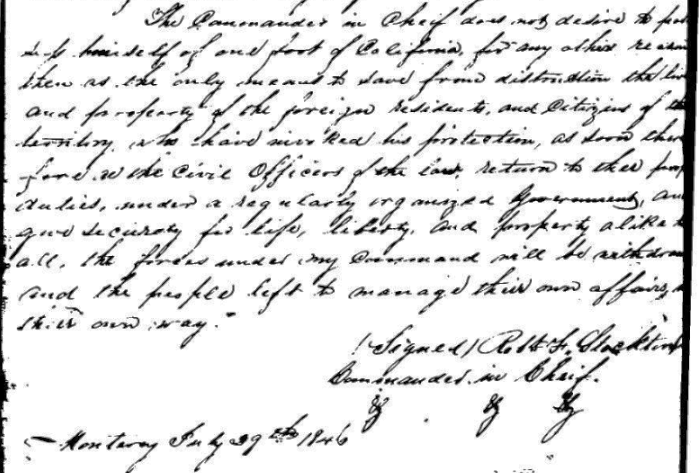
On August 29, 1846, an editorial writer in The Californian expressed similar sentiments:
The destiny of California is fixed—she is to become a free and independent state—a member of the North American confederacy. She is no longer to be subject to a foreign arbitrary power, to domestic revolutions or military rule. She is to make her own laws, manage her own resources, and found those institutions in which her children are to find a happy home.

Of course the Mexican authorities saw things quite differently. On June 17, 1846, José Castro, Lieutenant Colonel of Cavalry in the Mexican Army and acting General Commandant of the Department of California, issued a proclamation of his own:
Fellow Countrymen: The defence of our liberty, the true religion which our Fathers possessed, and our independence calls upon us to sacrifice ourselves rather than lose these inestimable blessings; banish from your hearts all petty resentments, turn you, and behold yourselves, these families, these innocent little ones, which have unfortunately fallen into the hands of our enemies; dragged from the bosoms of their fathers, who are prisoners among foreigners, and are calling upon us to succor them. There is still time for us to rise ‘en masse’ as irresistible as retributive. You need not doubt but that divine providence will direct us in the way to glory. You should not vascilate [sic] because of the smallness of the garrison of the General Head Quarters, for he who first will sacrifice himself, will be your friend and fellow citizen.
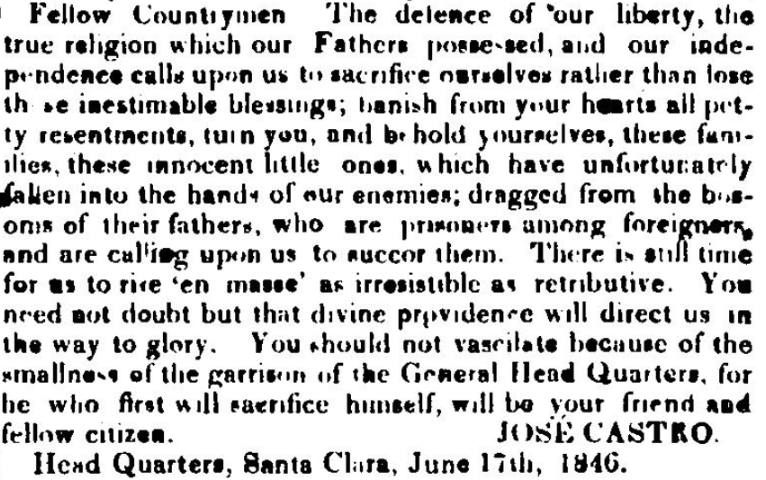
Lieutenant Colonel Castro’s hope was in vain, however. In March 1847 American military and civil authority coalesced in the person of Brigadier General and Governor of California S.W. Kearny who issued the following circular:
To all whom it may Concern, Be it known that the President of the United States, desirous to give and secure to the People of California a share of the good government and happy civil organization enjoyed by the people of the United States, and to protect them at the same time, from the attacks of foreign foes, and from internal commotions,—has invested the undersigned with separate and distinct powers, Civil and Military; a cordial cooperation in the exercise of which, it is hoped and believed will have the happy results desired.
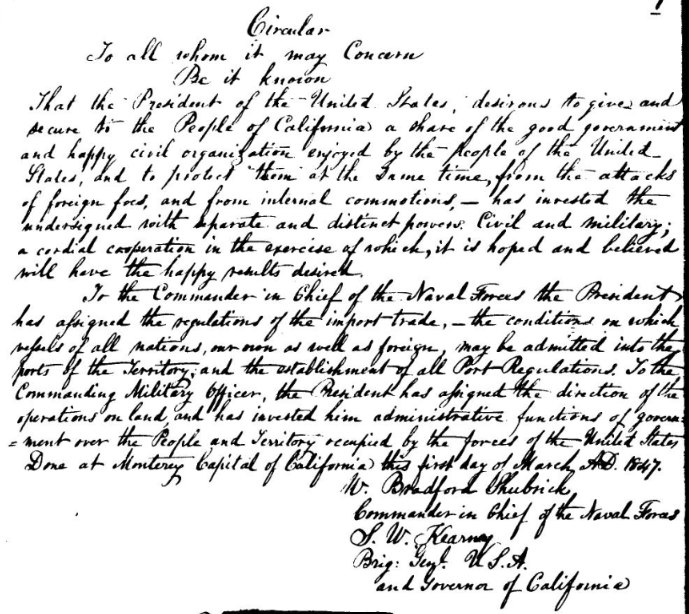
A year hence, Colonel R.B. Mason superseded Kearny as Governor of California, and on May 7, 1848, he announced America’s ratification of the Treaty of Guadalupe Hidalgo, ending the war:
Proclamation to the People of Upper California
The undersigned has the pleasure to announce the ratification of a Treaty of Peace and Friendship between the United States of America and the Republic of Mexico by which Upper California is ceded to the United States.
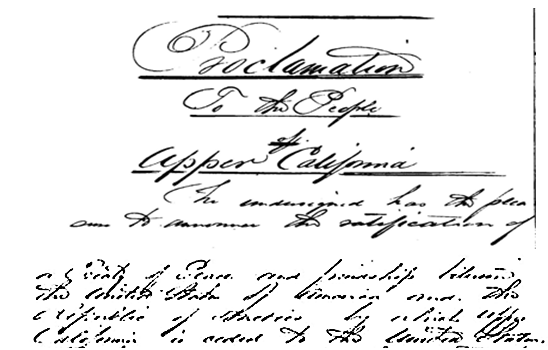
Even after the conclusion of the treaty it would be an understatement to say that United States authorities in California were improvising in response to circumstances. In August 1848 Brevet Captain and Secretary of State H.W. Halleck beseeched the U.S. Army interpreter in Los Angeles to continue his service as 1st Alcalde, essentially to serve as mayor.
I am directed by the Governor to acknowledge the receipt of your letter of the 2nd inst. and to inform you that a military force will be continued at Los Angeles and that you will be retained as Govt. interpreter and translator for the Southern Mil. Dist. The Governor is exceedingly anxious that you continue in the performance of your duties as 1st Alcalde as heretofore. The resignation of an American Alcalde at the present juncture will be likely to produce very erroneous impressions among the ignorant and excitable people of this country, and it is the imperative duty of Americans under such circumstances to make every personal sacrifice and to run any exertion in their power to preserve the peace and quiet of the country.
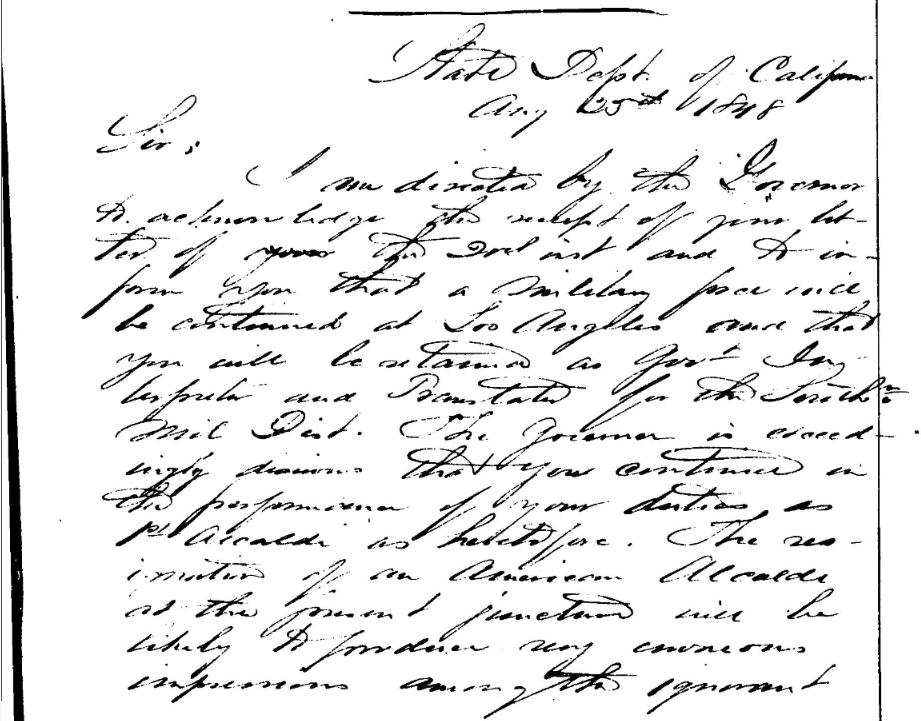
Were there lawyers involved? Surely there were, and more—there were judges. The following is a letter from Gov. R.B. Mason writing from Monterey on April 5, 1848, to 1st Alcalde Don Pedro C. Carrillo of Santa Barbara regarding the trial of one Benjamin Foxon for murder.
As there [are] at this time no regularly organized Courts in California before which Foxon can be arraigned and tried, and that so atrocious a crime as murder may not go unpunished I enclose a commission appointing yourself and Estavan Ardisson judges to hold a special Court for the trial of the said Foxon on the charges herewith transmitted. You will cause a jury of twelve good men to be empannelled for his trial. It would be well to summon eighteen or twenty jurors, so that if any are objected to there may be others on the spot to supply their places.
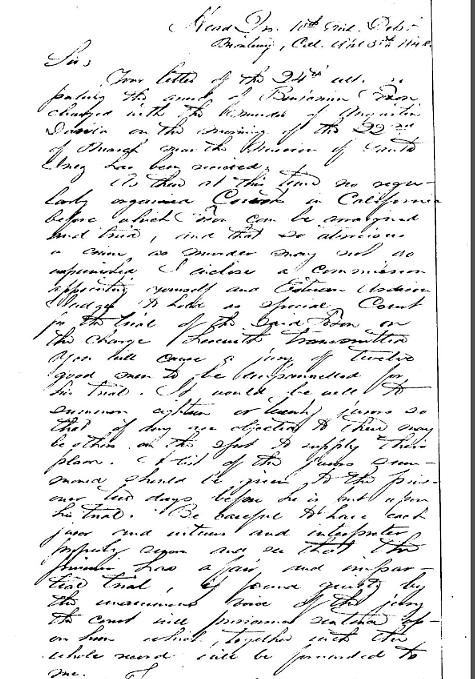
Beyond the implicit use of violence in overthrowing the established government of Upper California, there were guns in abundance under the new order:
I send the Bark Anita belonging to the U.S. Qtr. Mrs. Dept. in Oregon with a liberal supply of arms and ammunition to be delivered to you. The officers of the territory who are accountable for this property will send by the Bark receipts which upon the arrival of the property be pleased to sign and return to them.
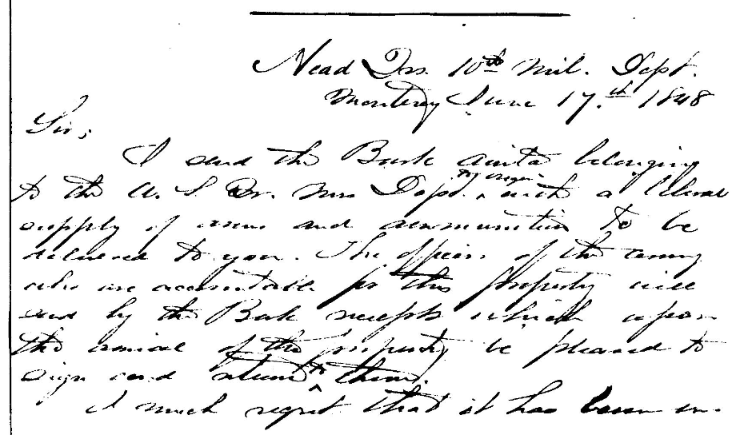
Despite the conflation of military and civil authority in Monterey, those working at the level of local government were thrown onto their own resources in matters of money. Here’s Captain Halleck writing to 1st Alcalde Don Pedro C. Carrillo of Santa Barbara telling him where the buck stops:
The Alcalde of Santa Barbara must resort to similar means to raise money to defray the necessary expenses of his office. He should endeavor to employ his prisoners in such a way as to earn those men subsistence, and to pay the guard required to secure them. The U.S. officer cannot be called upon to defray such municipal expenses. The civil authorities must under all ordinary circumstances not only take care of their own prisoners but also attend to the essentials of all civil processes. The interference of the military is to be called for only when forcible resistance is made to the execution of the law, and never for such purposes as the serving of civil processes and the collection of debt. It must be remembered that the military are not the agents of the municipal officers of California and cannot properly be called upon to act in that capacity, although they will always be ready to lend them all necessary aid and assistance to the civil officers in the execution of their duties.
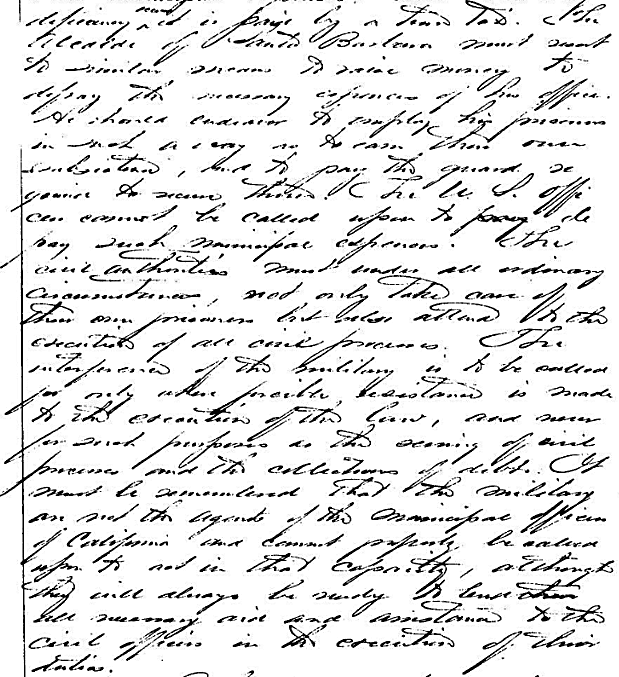
The lines of accountability were blurred not only with regard to civil and military authority, but also with regard to the separation of church and state. Here Captain Halleck writes to Colonel J.D. Stevenson in July 1848:
I am directed by the Governor to furnish you with such information from this office as may be deemed useful to you, guidance on the management of the affairs of the Missions in your district.
By the Mexican law of Aug. 17th 1833 the missions of Upper and Lower California were secularized and made the property of the government. Each mission was to constitute a parish and be placed under the charge of a parish priest of the secular clergy with a fixed salary. The churches of the several missions, with the sacred vessels, ornaments and other appurtenances and such adjacent buildings as the government might deem necessary were to be assigned for the use of the parish.
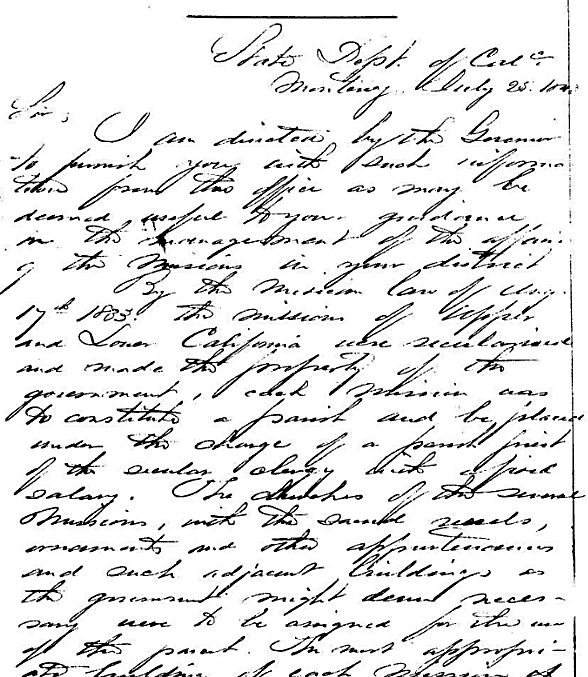
Then as now, it was disingenuous for the United States to wrap its imperialist goals in the mantle of American Exceptionalism. President Polk wanted what belonged to Mexico, and he got it by any means necessary. For clarity of both the object and result of the Mexican-American War as it pertained to Upper California, it’s refreshing to revisit the statement of the Military Governor of California, Colonel R.B. Mason, 1st Dragoons, writing on conquest and possession in 1847:
This is a Military Government and the Supreme Power as you say, is vested in the Senior Military officer of the Territory.
My instructions tell me—It is the duty of the Executive to carry on the war, with all the rights and subject to all the duties, imposed by the laws of nations: a Code binding on both belligerents. The possession of portions of the enemy’s territory, acquired by justifiable acts of war, gives to us the right of Government, during the continuance of our possession, and imposes on us a duty to the inhabitants who are thus placed under our dominion. This right of possession, however, is temporary, unless made absolute by subsequent events. If, being in possession, a Treaty of Peace is made and duly ratified on the principle of “Uti possidetis,” that is, that each of the belligerent parties shall enjoy the territory of which it shall be in possession at the date of the Treaty: or if the surrender of the territory is not stipulated in the Treaty so ratified, then the imperfect title acquired by conquest, is made absolute, and the inhabitants with the territory, are entitled to all the benefits of the Federal Constitution of the United States, to the same extent as the citizens of any other part of the Union.
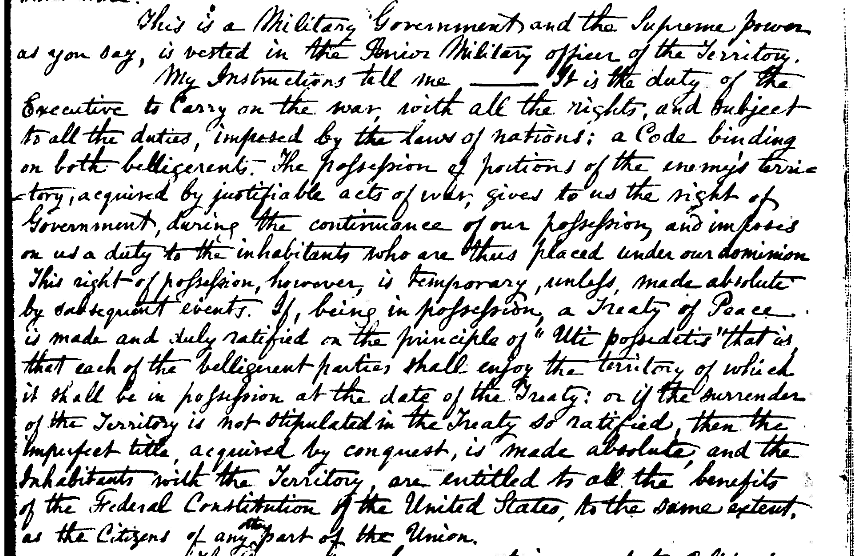
As compelling and significant as Readex’s Territorial Papers of the United States, 1764-1953, are, it’s worth noting that Readex offers a number of other resources for this era, among them the U.S. Congressional Serial Set, 1817-1994. As the official record of the U.S. Congress, the Serial Set includes among other things the definitive maps which informed policy and legislation. This map from the U.S. Geological Survey (based on that of Disturnell) is an excellent example of the quality of material that characterizes the Serial Set.
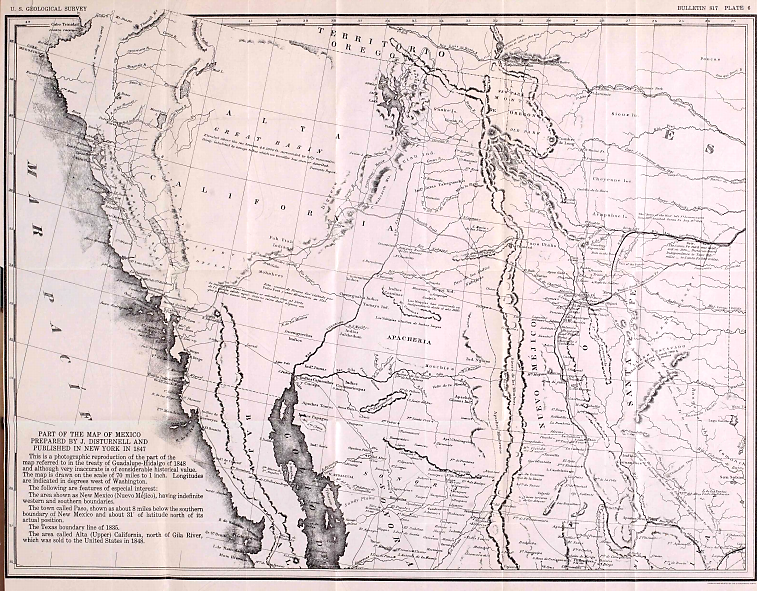
For more information about Territorial Papers of the United States or other digital collections of American government publications, please contact Readex.



